Historicizing Natural Hazards and Human-Induced Landscape Transformation in a Tropical Mountainous Environment in Africa: Narratives from Elderly Citizens
Abstract
1. Introduction
2. Study Area
3. Materials and Methods
3.1. Data Collection
3.1.1. Selection of the Study Participants
3.1.2. Historical Narratives with the Elderly Citizens
3.1.3. Reconstructing of Key Events with a Timeline
3.1.4. Participatory Mapping and Spatial Reference of Events
3.1.5. Field Assessment of the Extent of Human Activities
- Vegetation characteristics: the density and type of vegetation, such as native species versus invasive plants;
- Land use: the size and distribution of agricultural fields, settlements, commercial areas, and road infrastructure;
- Signs of soil erosion: evidence of erosion along riverbanks or hillsides and sediment deposits in lower areas;
- Water quality: water clarity and the presence of debris or foam in rivers.
3.2. Secondary Data Sources
3.3. Land Use/Cover Change Analysis with Historical Panchromatic Aerial Photographs and Satellite Images
4. Results
4.1. Watershed Characteristics
4.2. The Characterization of Watersheds During the Colonial Era (1940–1962)
4.2.1. Land Use/Cover
4.2.2. Land Use and Management Practices
4.2.3. Hydrology
4.2.4. Natural Hazards
4.2.5. The Temporal Trend in Reported Natural Hazards in Relation to the Ages of the Elderly
4.3. Catchment Characteristics in the Post-Colonial Era (1962–2021)
4.4. Land Use/Cover Change Analysis with the 1954 Aerial Panchromatic Photographs
4.5. Population Dynamics
4.6. Restoration Programs and Natural Hazards
5. Discussion
5.1. The Added Value and Limitations of the Elderly Approach—Can the Information Be Trusted?
5.2. Natural Hazards and Forest Cover Changes
5.3. Influence of Land Management Practices and Farming Systems on Natural Hazards
5.4. Population Growth and Infrastructure Development in Relation to Natural Hazard Risks
5.5. Natural Hazards and Climate Variability
6. Conclusions
Author Contributions
Funding
Institutional Review Board Statement
Data Availability Statement
Acknowledgments
Conflicts of Interest
Appendix A
- How long have you lived in this area?
- From the time you started understanding, what do you remember about your village? How many were you in this village (household)? Show on the map where your houses were located.
- How did your village look like generally? Or what was in the environment when you were young (structure of houses, roads, budlings, wetlands, forest, etc.) for FGDs use the map to show how the landscape looked like in the past and What it looks like currently.
- What changes on the landscape do you remember happened? what has changed, what has not changed in your environment when did the change happen and where did it happen?—Use the timeline to re-member and the map to show where the changes occurred.
- What about the river in your area, can you tell me about its history/evolution through time?
- How were the land managed, what crops did you grow?
- Any policies that existed?
- Have you experienced landslides and floods in the past?
- If yes, when did they happen—which years/months/seasons—use the timeline of historical political or social events to remember.
Appendix A.1
| Year | Historical Event/Change | Visualization of Landscape Change | ||
| Political and cultural changes (new laws, policies and practices, immigrants) | Socio-economic changes (livelihoods, farming practices, promotion of certain crops, population, infrastructure, building architecture) | Environmental/landscape changes (deforestation, afforestation, what natural hazards occurred) | Using the available map, show how the landscape looked like in this period? (forested, terraced or not, bare, bushy, uncultivated, wetland, grazing land, uninhabited, etc.) | |
Appendix A.2
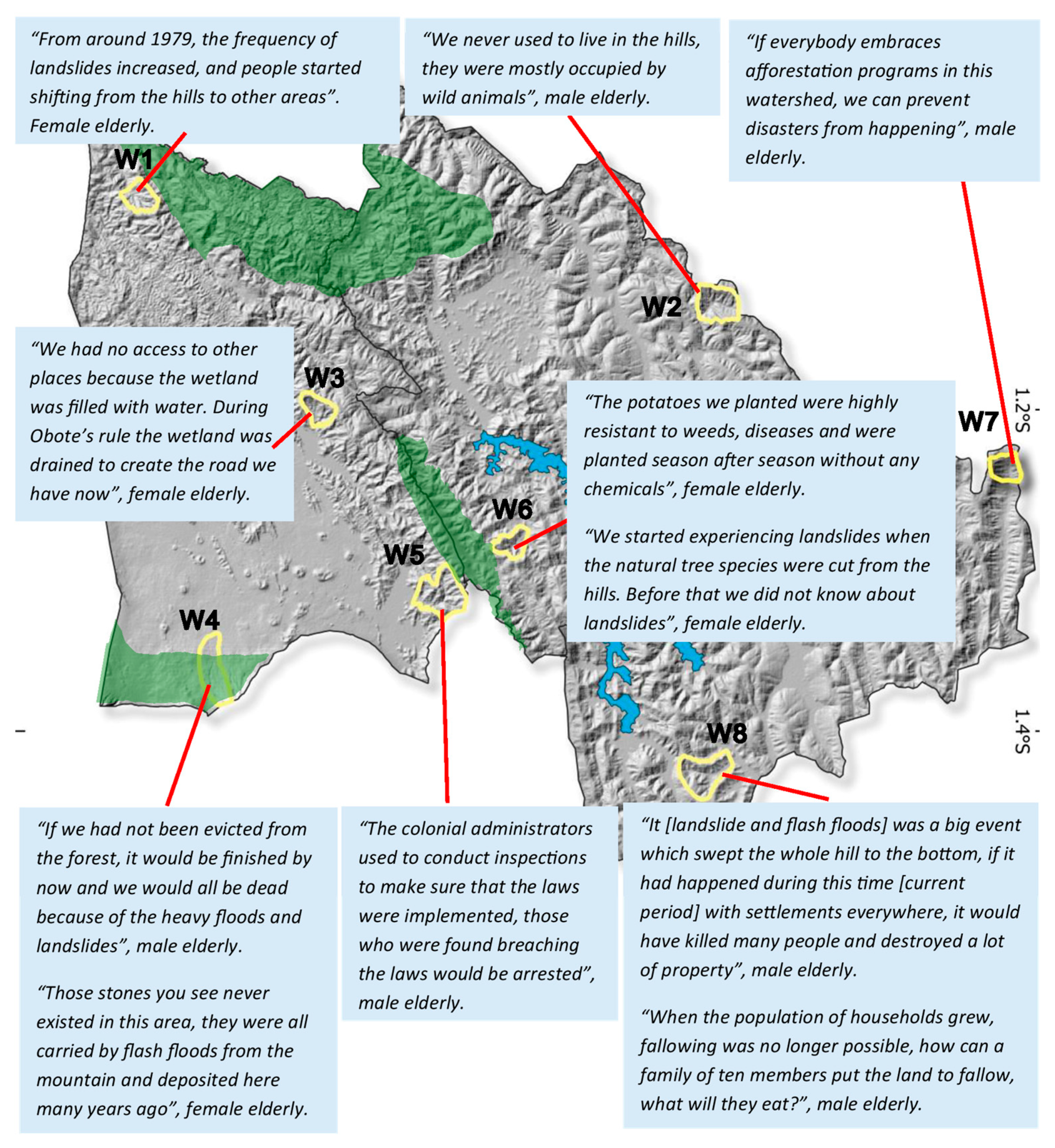
Appendix A.3
| W1—Nteko | ||
| Dates | National/Regional Context | Local Events |
| 1932 | Pre-colonial period | Park boundary was established separating Bwindi forest and communities |
| 1960 | Colonial period | Heavy deforestation in the catchment started |
| 1979 | Obote I president | Landslides experienced and people started shifting due to landslides |
| 1991 | Museveni’s rule | Bwindi forest was designated a national park |
| 2016 | Museveni’s rule | Restoration program by NGOs to plant indigenous trees |
| 2019 | Museveni’s rule | Heavy landslides occurred |
| W2—Kyokezo | ||
| Dates | National/regional context | Local events |
| 1950–60 | Colonial period | Resettlement scheme took place as a depopulation strategy |
| 1971 | Obote I president | The natural forest started to decline, replaced with eucalyptus |
| 1980 | Obote II rule | Population grew, land fragmentation |
| 1986 | Museveni became president | Many iron sheet-roofed houses; fallowing competently ended |
| 1998 | Museveni’s rule | The first road was constructed |
| 2000 | Museveni’s rule | Swamp drainage |
| 2009 | Museveni’s rule | The first serious landslides occurred killing 6 people and destroying several properties. Many large gulleys were formed |
| Museveni’s rule | Buying and selling of land increased; land fragmentation | |
| April 2017 | Museveni’s rule | Deadly landslides |
| 2004 | Museveni’s rule | Road constructed began |
| 1980 | Obote II rule | Over-population and cultivation |
| W3—Nyundo | ||
| Dates | National/regional context | Local events |
| 1952 | Colonial period | Mass wetland drainage for cultivation and road access |
| 1966–70s | Obote I rule | Land management practices abandoned |
| 1971 | Obote I president | Construction of many roads cutting through the mountains |
| 1980 | Obote II rule | Population increase, over-cultivation overgrazing; disasters increased, happening in April and September every year |
| 1990–98 | Museveni’s rule | Fallowing was no more |
| 2000 | Museveni’s rule | Eucalyptus dominated the landscape, natural tree species cut down |
| 2004 | Museveni’s rule | Road constructed began |
| W4—Rukonji | ||
| Dates | National/regional context | Local events |
| 1950 | Colonial period | Muhabura forest heavily cut down for cultivation |
| 1957 | Colonial period | Flash floods |
| April 1974 | President Amin rule | Heavy flashfloods involving deaths occurred |
| March 1982 | Obote II rule | Heavy flashfloods involving deaths occurred |
| April 1988 | President Museveni’s rule | Heavy flashfloods involving deaths occurred |
| 1991 | Museveni’s rule | Forest designated a national park and the regrowth of the forest |
| W5—Chibumba | ||
| Dates | National/regional context | Local events |
| 1950 | Colonial period | Landslides occurred in the hills, people relocated to lowlands |
| 1954 | Colonial period | Fallowing, planting elephant grass along contours, black wattle trees enforced |
| 1957 | Colonial period | Depopulation plan, people were resettled |
| 1959 | Colonial period | Rwandese war, immigrants |
| 1960 | Colonial period | Mining of tin |
| 1966–70s | Obote I rule | Land management practices abandoned, natural trees cut down, cultivating in the swamp |
| 1969 | Obote I president | Iron-sheet houses |
| 1980 | Obote II rule | Wetland in the valley was reclaimed and finished |
| 1981 | Obote II rule | Natural hazards, especially floods increased in the catchment |
| 1986 | Museveni’s rule | Road construction |
| W6—Kacereere | ||
| Dates | National/regional context | Local events |
| 1936 | Pre-colonial period | Echuya forest separated from community land |
| 1959 | Colonial period | Echuya forest gazetted a forest reserve |
| 1955–66 | Colonial period | Resettlement plan for depopulation happened |
| 1960 | Colonial period | Sinkholes experienced |
| 1970 | Obote I rule | Land management practices abandoned; natural trees cut down replaced with exotic ones |
| 1974 | President Amin rule | Elephants left the catchment |
| 1979 | President Amin rule | Over cultivation and shortage of land |
| 1980–90 | Obote II rule | Landslides and floods were experienced, and gulleys started to form |
| Apr-84 | Obote II rule | Serious flashfloods happened and swept crops and houses |
| 1990–98 | Museveni’s rule | Wetland lost completely because of siltation |
| Sep-94 | Museveni’s rule | Landslides occurred and destroyed 3 houses, bridges, animals, and crops |
| 2016 | Museveni’s rule | Soil and water conservation programs introduced |
| W7—Kahondo | ||
| Dates | National/regional context | Local events |
| 1946 | Colonial period | Landslides occurred and killed livestock, destroyed crops |
| 1950 | Colonial period | First main road constructed |
| 1954 | Colonial period | Fallowing, planting elephant grass along contours, black wattle trees enforced |
| 1956–1959 | Colonial period | The first iron-sheet houses were built |
| 1966–70s | Obote I rule | Land management practices abandoned, natural trees cut down, cultivating in the swamp |
| 1971 | Obote I president | Public land became private land with land titles. There was no source of water, the first borehole was constructed. A river was formed and continues to flow |
| 1980 | Obote II rule | Overpopulation of people and livestock, overgrazing and cattle trails all over the landscape, over cultivation |
| 1984 | Obote II rule | Buying and selling of food, food scarcity |
| 1990–98 | Museveni’s rule | Gullies started forming in the catchment |
| 1992 | Museveni’s rule | Severe famine happened in 1992 due to drought, and pests and diseases |
| 2000 | Museveni’s rule | Afforestation programs introduced, with Eucalyptus and pine dominating |
| 2005–2009 | Museveni’s rule | Soil and water conservation programs introduced |
| April 2013 | Serious landslides and floods occurred | |
| W8—Kibuga | ||
| Dates | National/regional context | Local events |
| 1945 | Colonial period | Deadly landslides occurred |
| 1952 | Colonial period | Mass wetland drainage |
| 1966–70s | Obote I rule | Land management practices abandoned |
| 1971 | Obote I president | Construction of many roads cutting through the mountains |
| 1972 | Immigration started | Population increase |
| 1980 | Obote II rule | Over-cultivation and overgrazing set in; landslides and floods increased |
| 1990–98 | Museveni’s rule | The natural vegetation began to shrink, Eucalyptus dominated the land cover, iron-sheet houses replaced grass-thatched houses; fallowing was no more |
| Museveni’s rule | Buying and selling of land increased; land fragmentation | |
| April 2017 | Museveni’s rule | Deadly landslides |
| 2004 | Museveni’s rule | Road construction began, more landsides occurred |
| 1980 | Obote II rule | Over-population and -cultivation; landslides and flash floods |
Appendix B
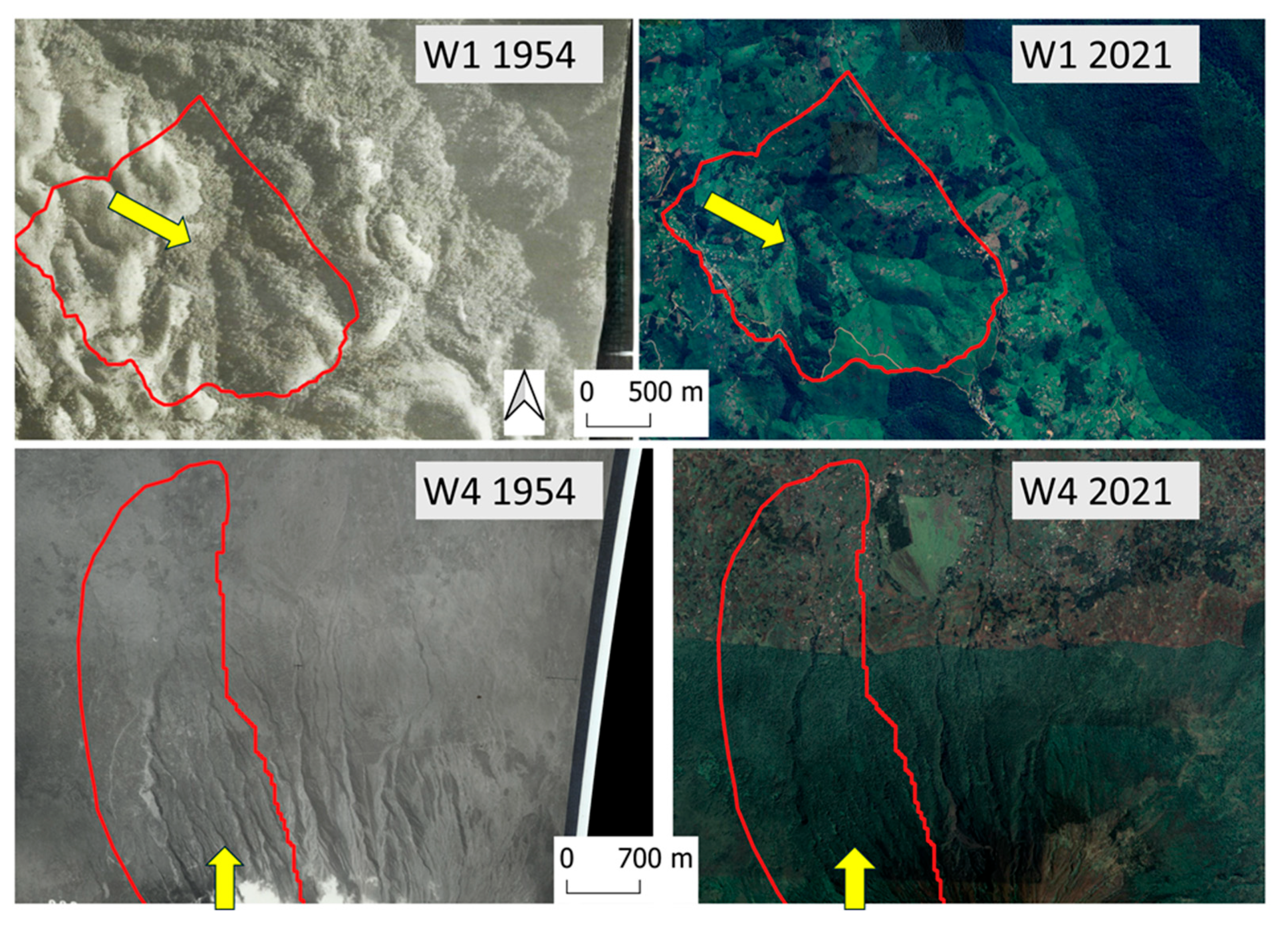
References
- Luino, F.; Barriendos, M.; Gizzi, F.T.; Glaser, R.; Gruetzner, C.; Palmieri, W.; Porfido, S.; Sangster, H.; Turconi, L. Historical data for natural hazard risk Mitigation and land use planning. Land 2023, 12, 1777. [Google Scholar] [CrossRef]
- Sidle, R.C.; Taylor, D.; Lu, X.X.; Adger, W.N.; Lowe, D.J.; de Lange, W.P.; Newnham, R.M.; Dodson, J.R. Interactions of Natural Hazards and Society in Austral-Asia: Evidence in Past and Recent Records. Quat. Int. 2004, 118–119, 181–203. [Google Scholar] [CrossRef]
- Napolitano, E.; Marchesini, I.; Salvati, P.; Donnini, M.; Bianchi, C.; Guzzetti, F. LAND-DeFeND—An Innovative Database Structure for Landslides and Floods and Their Consequences. J. Environ. Manag. 2018, 207, 203–218. [Google Scholar] [CrossRef]
- Hill, E.M.; McCaughey, J.W.; Switzer, A.D.; Lallemant, D.; Wang, Y.; Sathiakumar, S. Human Amplification of Secondary Earthquake Hazards through Environmental Modifications. Nat. Rev. Earth Environ. 2024, 5, 463–476. [Google Scholar] [CrossRef]
- Dille, A.; Dewitte, O.; Handwerger, A.L.; d’Oreye, N.; Derauw, D.; Ganza Bamulezi, G.; Ilombe Mawe, G.; Michellier, C.; Moeyersons, J.; Monsieurs, E.; et al. Acceleration of a Large Deep-Seated Tropical Landslide Due to Urbanization Feedback. Nat. Geosci. 2022, 15, 1048–1055. [Google Scholar] [CrossRef]
- Deijns, A.A.J.; Michéa, D.; Déprez, A.; Malet, J.-P.; Kervyn, F.; Thiery, W.; Dewitte, O. A Semi-Supervised Multi-Temporal Landslide and Flash Flood Event Detection Methodology for Unexplored Regions Using Massive Satellite Image Time Series. ISPRS J. Photogramm. Remote Sens. 2024, 215, 400–418. [Google Scholar] [CrossRef]
- Wang, X.; Fan, X.; Fang, C.; Dai, L.; Zhang, W.; Zheng, H.; Xu, Q. Long-Term Landslide Evolution and Restoration After the Wenchuan Earthquake Revealed by Time-Series Remote Sensing Images. Geophys. Res. Lett. 2024, 51, e2023GL106422. [Google Scholar] [CrossRef]
- IPCC. Climate Change 2022: Impacts, Adaptation, and Vulnerability. Contribution of Working Group II to the Sixth Assessment Report of the Intergovernmental Panel on Climate Change; Cambridge University Press: Cambridge, UK; New York, NY, USA, 2022. [Google Scholar] [CrossRef]
- Froude, M.J.; Petley, D.N. Global Fatal Landslide Occurrence 2004 to 2016. Nat. Hazards Earth Syst. Sci. 2018, 18, 2161–2181. [Google Scholar] [CrossRef]
- Cendrero, A.; Forte, L.M.; Remondo, J.; Cuesta-Albertos, J.A. Anthropocene Geomorphic Change Climate or Human Activities? Earth’s Future 2020, 8, e2019EF001305. [Google Scholar] [CrossRef]
- Cendrero, A.; Remondo, J.; Beylich, A.A.; Cienciala, P.; Forte, L.M.; Golosov, V.N.; Gusarov, A.V.; Kijowska-Strugała, M.; Laute, K.; Li, D.; et al. Denudation and Geomorphic Change in the Anthropocene; a Global Overview. Earth-Sci. Rev. 2022, 233, 104186. [Google Scholar] [CrossRef]
- Depicker, A.; Govers, G.; Jacobs, L.; Campforts, B.; Uwihirwe, J.; Dewitte, O. Interactions between Deforestation, Landscape Rejuvenation, and Shallow Landslides in the North Tanganyika–Kivu Rift Region, Africa. Earth Surf. Dyn. 2021, 9, 445–462. [Google Scholar] [CrossRef]
- Rengers, F.K.; McGuire, L.A.; Kean, J.W.; Staley, D.M.; Hobley, D.E.J. Model Simulations of Flood and Debris Flow Timing in Steep Catchments after Wildfire. Water Resour. Res. 2016, 52, 6041–6061. [Google Scholar] [CrossRef]
- Ozturk, U.; Bozzolan, E.; Holcombe, E.A.; Shukla, R.; Pianosi, F.; Wagener, T. How Climate Change and Unplanned Urban Sprawl Bring More Landslides. Nature 2022, 608, 262–265. [Google Scholar] [CrossRef] [PubMed]
- McAdoo, B.G.; Quak, M.; Gnyawali, K.R.; Adhikari, B.R.; Devkota, S.; Rajbhandari, P.L.; Sudmeier-Rieux, K. Roads and Landslides in Nepal: How Development Affects Environmental Risk. Nat. Hazards Earth Syst. Sci. 2018, 18, 3203–3210. [Google Scholar] [CrossRef]
- Depicker, A.; Jacobs, L.; Mboga, N.; Smets, B.; Van Rompaey, A.; Lennert, M.; Wolff, E.; Kervyn, F.; Michellier, C.; Dewitte, O.; et al. Historical Dynamics of Landslide Risk from Population and Forest-Cover Changes in the Kivu Rift. Nat. Sustain. 2021, 4, 965–974. [Google Scholar] [CrossRef]
- Rentschler, J.; Salhab, M.; Jafino, B.A. Flood Exposure and Poverty in 188 Countries. Nat. Commun. 2022, 13, 3527. [Google Scholar] [CrossRef]
- CRED-UNDRR. Human Cost of Disasters: An Overview of the Last 20 Years (2000–2019); UCLouvain: Ottignies-Louvain-la-Neuve, Belgium, 2020. [Google Scholar] [CrossRef]
- Otto, F.E.L.; Raju, E. Harbingers of Decades of Unnatural Disasters. Commun. Earth Environ. 2023, 4, 280. [Google Scholar] [CrossRef]
- Raju, E.; Boyd, E.; Otto, F. Stop Blaming the Climate for Disasters. Commun. Earth Environ. 2022, 3, 1. [Google Scholar] [CrossRef]
- Ferrer, J.V.; Samprogna Mohor, G.; Dewitte, O.; Pánek, T.; Reyes-Carmona, C.; Handwerger, A.L.; Hürlimann, M.; Köhler, L.; Teshebaeva, K.; Thieken, A.H.; et al. Human Settlement Pressure Drives Slow-Moving Landslide Exposure. Earth’s Future 2024, 12, e2024EF004830. [Google Scholar] [CrossRef]
- Merz, B.; Blöschl, G.; Vorogushyn, S.; Dottori, F.; Aerts, J.C.J.H.; Bates, P.; Bertola, M.; Kemter, M.; Kreibich, H.; Upmanu, L.; et al. Causes, Impacts and Patterns of Disastrous River Floods. Nat. Rev. Earth Environ. 2021, 2, 592–609. [Google Scholar] [CrossRef]
- Muñoz-Torrero Manchado, A.; Allen, S.; Ballesteros-Cánovas, J.A.; Dhakal, A.; Dhital, M.R.; Stoffel, M. Three Decades of Landslide Activity in Western Nepal: New Insights into Trends and Climate Drivers. Landslides 2021, 18, 2001–2015. [Google Scholar] [CrossRef]
- Monsieurs, E.; Kirschbaum, D.B.; Thiery, W.; van Lipzig, N.; Kervyn, M.; Demoulin, A.; Jacobs, L.; Kervyn, F.; Dewitte, O. Constraints on Landslide-Climate Research Imposed by the Reality of Fieldwork in Central Africa. In Proceedings of the 3rd North American Symposium on Landslides, Roanake, Virginia, 4–8 June 2017. [Google Scholar]
- Juang, C.S.; Stanley, T.A.; Kirschbaum, D.B. Using Citizen Science to Expand the Global Map of Landslides: Introducing the Cooperative Open Online Landslide Repository (COOLR). PLoS ONE 2019, 14, e0218657. [Google Scholar] [CrossRef] [PubMed]
- Schlögl, M.; Fuchs, S.; Scheidl, C.; Heiser, M. Trends in Torrential Flooding in the Austrian Alps: A Combination of Climate Change, Exposure Dynamics, and Mitigation Measures. Clim. Risk Manag. 2021, 32, 100294. [Google Scholar] [CrossRef]
- Nyssen, J.; Poesen, J.; Veyret-Picot, M.; Moeyersons, J.; Haile, M.; Deckers, J.; Dewit, J.; Naudts, J.; Teka, K.; Govers, G. Assessment of Gully Erosion Rates through Interviews and Measurements: A Case Study from Northern Ethiopia. Earth Surf. Process. Landf. 2006, 31, 167–185. [Google Scholar] [CrossRef]
- McCall, M.K. Participatory Mapping and Participatory GIS (PGIS) for CRA, Community DRR and Hazard Assessment; Participation Resources: Geneva, Switzerland, 2008. [Google Scholar] [CrossRef]
- Solecka, I.; Krajewski, P.; Krzyżanek, A.; Garczyńska, A. Citizens’ Perceptions of Landscape Changes and Their Driving Forces: Evidence from Poland. Int. J. Environ. Res. Public Health 2022, 19, 1688. [Google Scholar] [CrossRef]
- Barclay, J.; Robertson, R.; Armijos, M.T. Scientists as Storytellers: The Explanatory Power of Stories Told about Environmental Crises. Nat. Hazards Earth Syst. Sci. 2023, 23, 3603–3615. [Google Scholar] [CrossRef]
- Young, N.E.; Evangelista, P.H.; Mengitsu, T.; Leisz, S. Twenty-Three Years of Forest Cover Change in Protected Areas under Different Governance Strategies: A Case Study from Ethiopia’s Southern Highlands. Land Use Policy 2020, 91, 104426. [Google Scholar] [CrossRef]
- Kubwimana, D.; Ait Brahim, L.; Nkurunziza, P.; Dille, A.; Depicker, A.; Nahimana, L.; Abdelouafi, A.; Dewitte, O. Characteristics and Distribution of Landslides in the Populated Hillslopes of Bujumbura, Burundi. Geosciences 2021, 11, 259. [Google Scholar] [CrossRef]
- Riquelme, A.; Del Soldato, M.; Tomás, R.; Cano, M.; Jordá Bordehore, L.; Moretti, S. Digital Landform Reconstruction Using Old and Recent Open Access Digital Aerial Photos. Geomorphology 2019, 329, 206–223. [Google Scholar] [CrossRef]
- Luino, F.; Gizzi, F.T.; Palmieri, W.; Porfido, S.; Turconi, L. Historical Memory as an Effective and Useful Tool for Proper Land Use Planning: Lessons Learnt from Some Italian Cases. Land 2023, 12, 1751. [Google Scholar] [CrossRef]
- Depicker, A.; Govers, G.; Jacobs, L.; Vanmaercke, M.; Uwihirwe, J.; Campforts, B.; Kubwimana, D.; Maki Mateso, J.-C.; Mugaruka Bibentyo, T.; Nahimana, L.; et al. Mobilization Rates of Landslides in a Changing Tropical Environment: 60-Year Record over a Large Region of the East African Rift. Geomorphology 2024, 454, 109156. [Google Scholar] [CrossRef]
- Flicker, S.; Campo, P.O.; Monchalin, R.; Thistle, J.; Worthington, C.; Masching, R.; Guta, A.; Pooyak, S.; Whitebird, W.; Thomas, C. Research Done in “A Good Way”: The Importance of Indigenous Elder Involvement in HIV Community-Based. Am. J. Public Health 2015, 105, 1149–1154. [Google Scholar] [CrossRef] [PubMed]
- Lawrence, M.G.; Williams, S.; Nanz, P.; Renn, O. Characteristics, Potentials, and Challenges of Transdisciplinary Research. One Earth 2022, 5, 44–61. [Google Scholar] [CrossRef]
- Richardson, D. Reconstructing a Community with Oral History. Oral Hist. Rev. 2002, 29, 97–102. [Google Scholar] [CrossRef]
- Moezzi, M.; Janda, K.B.; Rotmann, S. Using Stories, Narratives, and Storytelling in Energy and Climate Change Research. Energy Res. Soc. Sci. 2017, 31, 1–10. [Google Scholar] [CrossRef]
- Turyahabwe, N.; Banana, A.Y. An Overview of History and Development of Forest Policy and Legislation in Uganda. Int. For. Rev. 2008, 10, 641–656. [Google Scholar] [CrossRef]
- Capitani, C.; Mukama, K.; Mbilinyi, B.; Malugu, I.O.; Munishi, P.K.T.; Burgess, N.D.; Platts, P.J.; Sallu, S.M.; Marchant, R. From Local Scenarios to National Maps: A Participatory Framework for Envisioning the Future of Tanzania. Ecol. Soc. 2016, 21, 4. [Google Scholar] [CrossRef]
- Gregory, K. Mapping the Landscape of Identity. In Yearbook (Conference of Latin Americanist Geographers); University of Texas Press: Austin, TX, USA, 2002; Volume 28, pp. 51–71. [Google Scholar]
- Hordijk, M.; Baud, I. The Role of Research and Knowledge Generation in Collective Action and Urban Governance: How Can Researchers Act as Catalysts? Habitat Int. 2006, 30, 668–689. [Google Scholar] [CrossRef]
- Ben Malek, H.; Berna, F.; D’Argembeau, A. Reconstructing the Times of Past and Future Personal Events. Memory 2017, 25, 1402–1411. [Google Scholar] [CrossRef]
- Hoffman, M.T.; Rohde, R.F. Rivers Through Time: Historical Changes in the Riparian Vegetation of the Semi-Arid, Winter Rainfall Region of South Africa in Response to Climate and Land Use. J. Hist. Biol. 2011, 44, 59–80. [Google Scholar] [CrossRef] [PubMed]
- Bwambale, B.; Nyeko, M.; Sekajugo, J.; Kervyn, M. The Essential Contribution of Indigenous Knowledge to Understanding Natural Hazards and Disaster Risk: Historical Evidence from the Rwenzori (Uganda). Nat. Hazards 2021, 110, 1847–1867. [Google Scholar] [CrossRef]
- Kanyiginya, V.; Twongyirwe, R.; Kagoro-Rugunda, G.; Sekajugo, J.; Mutyebere, R.; Deijns, A.A.J.; Kervyn, M.; Dewitte, O. Inventories of Natural Hazards in Under-Reported Regions: A Multi-Method Insight from a Tropical Mountainous Landscape. Afr. Geogr. Rev. 2024, 43, 827–846. [Google Scholar] [CrossRef]
- Nseka, D.; Mugagga, F.; Opedes, H.; Ayesiga, P.; Wasswa, H.; Mugume, I.; Nimusiima, A.; Nalwanga, F. The Damage Caused by Landslides in Socio-Economic Spheres within the Kigezi Highlands of southwestern Uganda. Environ. Socio-Econ. Stud. 2021, 9, 23–34. [Google Scholar] [CrossRef]
- UBOS. Statistical Abstract 2022; UBOS: Kampala, Uganda, 2022; pp. 1–336. [Google Scholar]
- UBOS. National Population and Housing Census; Main Report; UBOS: Kampala, Uganda, 2024; p. 73. [Google Scholar]
- Carswell, G. Farmers and Fallowing: Agricultural Change in Kigezi District, Uganda. Geogr. J. 2002, 168, 130–140. [Google Scholar] [CrossRef]
- Bagoora, F.D.K. Soil Erosion and Mass Wasting Risk in the Highland Area of Uganda. Mt. Res. Dev. 1988, 8, 173–182. [Google Scholar] [CrossRef]
- Twongyirwe, R.; Majaliwa, J.; Ebanyat, P.; Tenywa, M.; Sheil, D.; Heist, M.; Oluka, M.; Kumar, L. Dynamics of Forest Cover Conversion in and around Bwindi Impenetrable Forest, Southwestern Uganda. J. Appl. Sci. Environ. Manag. 2011, 15, 189–195. [Google Scholar] [CrossRef]
- Mwanjalolo, M.G.J.; Bernard, B.; Paul, M.I.; Joshua, W.; Sophie, K.; Cotilda, N.; Bob, N.; John, D.; Edward, S.; Barbara, N. Assessing the Extent of Historical, Current, and Future Land Use Systems in Uganda. Land 2018, 7, 132. [Google Scholar] [CrossRef]
- Monsieurs, E.; Jacobs, L.; Michellier, C.; Basimike Tchangaboba, J.; Bamulezi Ganza, G.; Kervyn, F.; Maki Mateso, J.-C.; Mugaruka Bibentyo, T.; Kalikone Buzera, C.; Nahimana, L.; et al. Landslide Inventory for Hazard Assessment in a Data-Poor Context: A Regional-Scale Approach in a Tropical African Environment. Landslides 2018, 15, 2195–2209. [Google Scholar] [CrossRef]
- OPM (Ed.) National Vulnerability and Risk Atlas of Uganda; OPM: Washington, DC, USA, 2019; Volume 1. [Google Scholar]
- Nseka, D.; Kakembo, V.; Bamutaze, Y.; Mugagga, F. Analysis of Topographic Parameters Underpinning Landslide Occurrence in Kigezi Highlands of Southwestern Uganda. Nat. Hazards 2019, 99, 973–989. [Google Scholar] [CrossRef]
- Atkinson, R.; Flint, J. Accessing Hidden and Hard-to-Reach Populations: Snowball Research Strategies. Soc. Res. Updat. 2001, 33, 1. [Google Scholar]
- Carter, N.; Bryant-Lukosius, D.; DiCenso, A.; Blythe, J.; Neville, A.J. The Use of Triangulation in Qualitative Research. Oncol. Nurs. Forum 2014, 41, 545–547. [Google Scholar] [CrossRef] [PubMed]
- Rocchio, F.J. Assessing Ecological Condition of Headwater Wetlands in the Southern Rocky Mountains Using a Vegetation Index of Biotic Integrity; Colorado State University: Fort Collins, CO, USA, 2007. [Google Scholar] [CrossRef]
- Ibsen, M.-L.; Denys, B. The Nature, Use and Problems of Historical Archives for the Temporal Occurrence of Landslides, with Specific Reference to the South Coast of Britain, Ventnor, Isle of Wight. Geomorphology 1996, 15, 241–258. [Google Scholar] [CrossRef]
- Ngologoza, P. Kigezi and Its People; Translation of Kigezi n’abantu Baamwo; East African Literature Bureau: Dar es Salaam, Tanzania, 1969. [Google Scholar]
- Purseglove, J.W. Land Use in the Over-Populated Areas of Kabale, Kigezi District, Uganda. East Afr. Agric. J. 1946, 12, 3–10. [Google Scholar] [CrossRef]
- Denoon, D. A History of Kigezi in South-West Uganda; The National Trust—Adult Education Centre: Kampala, Uganda, 1972; pp. 694–695. [Google Scholar]
- Department of Geology. Geological Map of Uganda; Geological Survey and Mines Department: Entebbe, Uganda, 2012.
- Teitelbaum, L.; Ginsburg, M.L.; Hopkins, R.W. Cognitive and Behavioural Impairment among Elderly People in Institutions Providing Different Levels of Care. Cmaj 1991, 144, 169–173. [Google Scholar]
- Bill, A.; Mark, I. Community Conservation Research in Africa: Principles and Comparative Practice; Working Papers; Community Conservation at Mgahinga Gorilla National Park in Uganda; University of Manchester: Manchester, UK, 1998; ISBN 190251814. [Google Scholar]
- Swetnam, T.W.; Allen, C.D.; Betancourt, J.L. Applied Historical Ecology: Using the Past to Manage for the Future. Ecol. Appl. 1999, 9, 1189–1206. [Google Scholar] [CrossRef]
- Oliva, A.; Olcina, J. Historical Floods and Territorial Planning: Lessons Learned and Opportunities Lost after the Santa Teresa Flood (1879) in the Segura Basin (Spain). Land 2024, 13, 28. [Google Scholar] [CrossRef]
- Blahut, J.; van Westen, C.J.; Sterlacchini, S. Analysis of Landslide Inventories for Accurate Prediction of Debris-Flow Source Areas. Geomorphology 2010, 119, 36–51. [Google Scholar] [CrossRef]
- UNDRR. Uganda Profile of Landslide and Flood Events in the Kigezi Region. DesInventar Database. DesInventar Sendai. Available online: https://www.desinventar.net (accessed on 3 March 2021).
- Hong, Y.; Alder, R.; Huffman, G. Evaluation of the Potential of NASA Multi-Satellite Precipitation Analysis in Global Landslide Hazard Assessment. Geophys. Res. Lett. 2006, 33, L22402. [Google Scholar] [CrossRef]
- Lathouwers, E.; Segers, Y.; Verstraeten, G. Reconstructing Valley Landscapes. GIS-Analyses of Past Land Use Changes in Three Flemish River Valleys since the Late 18th Century. Land Use Policy 2023, 135, 106960. [Google Scholar] [CrossRef]
- Bonney, R.; Phillips, T.B.; Ballard, H.L.; Enck, J.W. Can Citizen Science Enhance Public Understanding of Science? Public Underst. Sci. 2016, 25, 2–16. [Google Scholar] [CrossRef] [PubMed]
- Jacobs, L.; Kabaseke, C.; Bwambale, B.; Katutu, R.; Dewitte, O.; Mertens, K.; Maes, J.; Kervyn, M. The Geo-Observer Network: A Proof of Concept on Participatory Sensing of Disasters in a Remote Setting. Sci. Total Environ. 2019, 670, 245–261. [Google Scholar] [CrossRef]
- Sekajugo, J.; Kagoro-Rugunda, G.; Mutyebere, R.; Kabaseke, C.; Namara, E.; Dewitte, O.; Kervyn, M.; Jacobs, L. Can Citizen Scientists Provide a Reliable Geo- Hydrological Hazard Inventory? An Analysis of Biases, Sensitivity and Precision for the Rwenzori. Environ. Res. Lett. 2022, 17, 045011. [Google Scholar] [CrossRef]
- Jack, F.; Friedman, W.; Reese, E.; Zajac, R. Age-Related Differences in Memory for Time, Temporal Reconstruction, and the Availability and Use of Temporal Landmarks. Cogn. Dev. 2016, 37, 53–66. [Google Scholar] [CrossRef]
- Friedman, W.J.; Wilkins, A.J. Scale Effects in Memory for the Timeof Events. Mem. Cognit. 1985, 13, 168–175. [Google Scholar] [CrossRef]
- Baydala, L.; Worrell, S.; Fletcher, F.; Letendre, S.; Letendre, L.; Ruttan, L. “Making a Place of Respect”: Lessons Learned in Carrying out Consent Protocol with First Nations Elders. Prog Community Heal. Partnersh 2013, 7, 135–143. [Google Scholar]
- Andrews, G.J.; Kearns, R.A.; Kontos, P.; Wilson, V. “Their Finest Hour”: Older People, Oral Histories, and the Historical Geography of Social Life. Soc. Cult. Geogr. 2006, 7, 153–177. [Google Scholar] [CrossRef]
- Arazy, O.; Malkinson, D. A Framework of Observer-Based Biases in Citizen Science Biodiversity Monitoring: Semi-Structuring Unstructured Biodiversity Monitoring Protocols. Front. Ecol. Evol. 2021, 9, 693602. [Google Scholar] [CrossRef]
- Nsabimana, J.; Henry, S.; Ndayisenga, A.; Kubwimana, D.; Dewitte, O.; Kervyn, F.; Michellier, C. Geo-Hydrological Hazard Impacts, Vulnerability and Perception in Bujumbura (Burundi): A High-Resolution Field-Based Assessment in a Sprawling City. Land 2023, 12, 1876. [Google Scholar] [CrossRef]
- Corominas, J.; Van Westen, C.; Frattini, P.; Cascini, L.; Fotopoulou, S.; Catani, F.; Van Den Eeckhaut, M.; Mavrouli, O.; Agliardi, F.; Pitilakis, K.; et al. Recommendations for the Quantitative Analysis of Landslide Risk. Bull. Eng. Geol. Environ. 2014, 73, 209–263. [Google Scholar] [CrossRef]
- Foody, G.M.; See, L.; Fritz, S.; Van der Velde, M.; Perger, C.; Schill, C.; Boyd, D.S. Assessing the Accuracy of Volunteered Geographic Information Arising from Multiple Contributors to an Internet Based Collaborative Project. Trans. GIS 2013, 17, 847–860. [Google Scholar] [CrossRef]
- Mahlangu, M.; Garutsa, T.C. Application of Indigenous Knowledge Systems in Water Conservation and Management: The Case of Khambashe, Eastern Cape South Africa. Acad. J. Interdiscip. Stud. 2014, 3, 151–160. [Google Scholar] [CrossRef]
- Kizza, C.L.; Tenywa, M.M.; Majaliwa, J.G.M.; Kansiime, F.; Magunda, M.; Nakileza, B.; Barasa, B.; Gabiri, G.; Sebuliba, E.; Nampijja, J. Land Use/Cover Change Patterns in Highland Ecosystems of Lake Bunyonyi Catchment in Western Uganda. Afr. Crop Sci. J. 2017, 25, 43. [Google Scholar] [CrossRef]
- Barasa, B.; Egeru, A.; Patrick, O.; Fridah, M. Dynamics of Land Use/Cover Trends in Kanungu District, South-Western Uganda. J. Appl. Sci. Environ. Manag. 2011, 14, 67–70. [Google Scholar] [CrossRef][Green Version]
- Maki Mateso, J.-C.; Bielders, C.L.; Monsieurs, E.; Depicker, A.; Smets, B.; Tambala, T.; Bagalwa Mateso, L.; Dewitte, O. Characteristics and Causes of Natural and Human-Induced Landslides in a Tropical Mountainous Region: The Rift Flank West of Lake Kivu (Democratic Republic of the Congo). Nat. Hazards Earth Syst. Sci. 2023, 23, 643–666. [Google Scholar] [CrossRef]
- De Wit, M.P.; Crookes, D.J.; Van Wilgen, B.W. Conflicts of Interest in Environmental Management: Estimating. Biol. Invations 2001, 3, 167–178. [Google Scholar] [CrossRef]
- Babur, E.; Kara, O.; Fathi, R.A.; Susam, Y.E.; Riaz, M.; Arif, M.; Akhtar, K. Wattle Fencing Improved Soil Aggregate Stability, Organic Carbon Stocks and Biochemical Quality by Restoring Highly Eroded Mountain Region Soil. J. Environ. Manag. 2021, 288, 112489. [Google Scholar] [CrossRef] [PubMed]
- Tesfaw, A.; Alemu, D.; Feyera, S.; Teferi, E. Eucalyptus Succession on Croplands in the Highlands of Northwestern Ethiopia: Economic Impact Analysis Using Farm Household Model. Resources 2022, 11, 71. [Google Scholar] [CrossRef]
- Floodlist. At Least 9 Killed in Western Region Flash Floods. Available online: https://floodlist.com/africa/uganda-floods-kisoro-january-2022 (accessed on 22 December 2022).
- Wang, J.; Deng, Y.; Li, D.; Liu, Z.; Wen, L.; Huang, Z.; Jiang, D.; Lu, Y. Soil Aggregate Stability and Its Response to Overland Flow in Successive Eucalyptus Plantations in Subtropical China. Sci. Total Environ. 2022, 807, 151000. [Google Scholar] [CrossRef] [PubMed]
- Du, W.; Zhang, J.; Chen, H.; Wang, T. Do Ecological Evidences Support Biodiversity Optimizing Roles of Eucalyptus Plantation 4 Forests? SSRN Electron. J. 2022. Preprint. [Google Scholar]
- Hartter, J.; Ryan, S.J.; Mackenzie, C.A.; Goldman, A.; Diem, J.E.; Chapman, C.A. Now There Is No Land: A Story of Ethnic Migration in a Protected Area Landscape in Western Uganda. Popul. Environ. 2015, 36, 452–479. [Google Scholar] [CrossRef]
- Cornelis, W.; Waweru, G.; Araya, T. Building Resilience Against Drought and Floods: The Soil-Water Management Perspective. Sustain. Agric. Rev. 2019, 29, 125–142. [Google Scholar] [CrossRef]
- Sidle, R.C.; Bogaard, T.A. Dynamic Earth System and Ecological Controls of Rainfall-Initiated Landslides. Earth-Sci. Rev. 2016, 159, 275–291. [Google Scholar] [CrossRef]
- Rogger, M.; Agnoletti, M.; Alaoui, A.; Bathurst, J.C.; Bodner, G.; Borga, M.; Chaplot, V.; Gallart, F.; Glatzel, G.; Hall, J.; et al. Land Use Change Impacts on Floods at the Catchment Scale: Challenges and Opportunities for Future Research. Water Resour. Res. 2016, 2013, 5209–5219. [Google Scholar] [CrossRef] [PubMed]
- Schilirò, L.; Cevasco, A.; Esposito, C.; Mugnozza, G.S. Shallow Landslide Initiation on Terraced Slopes: Inferences from a Physically Based Approach. Geomat. Nat. Hazards Risk 2018, 9, 295–324. [Google Scholar] [CrossRef]
- Kitutu, M.G.; Muwanga, A.; Poesen, J.; Deckers, J.A. Farmer’s Perception on Landslide Occurrences in Bududa District, Eastern Uganda. Afr. J. Agric. Res. 2011, 6, 7–18. [Google Scholar]
- Sibomana, P.; Vanmaercke, M.; Nahayo, D.; Depicker, A.; Tychon, B.; Hubert, A.; Rukundo, E.; Dewitte, O. Potential effect of agricultural terraces on landslide occurrence: The tropical mountains of Rwanda. In Proceedings of the EGU General Assembly 2023, Vienna, Austria, 23–28 April 2023. EGU23-9126. [Google Scholar] [CrossRef]
- Srivastava, S.; Basche, A.; Traylor, E.; Roy, T. The Efficacy of Conservation Practices in Reducing Floods and Improving Water Quality. Front. Environ. Sci. 2023, 11, 1136989. [Google Scholar] [CrossRef]
- Sinore, T.; Kissi, E.; Aticho, A. The Effects of Biological Soil Conservation Practices and Community Perception toward These Practices in the Lemo District of Southern Ethiopia. Int. Soil Water Conserv. Res. 2018, 6, 123–130. [Google Scholar] [CrossRef]
- Mason, S.C.; Ouattara, K.; Taonda, S.J.B.; Palé, S.; Sohoro, A.; Kaboré, D. Soil and Cropping System Research in Semi-Arid West Africa as Related to the Potential for Conservation Agriculture. Int. J. Agric. Sustain. 2015, 13, 120–134. [Google Scholar] [CrossRef]
- Raj, S.; Chaudhary, S.; Ghule, N.S.; Baral, K.; Padhan, S.R.; Gawande, K.N.; Singh, V. Sustainable Farming and Soil Health Enhancement through Millet Cultivation: A Review. Int. J. Plant Soil Sci. 2024, 36, 222–233. [Google Scholar] [CrossRef]
- Tellman, B.; Sullivan, J.A.; Kuhn, C.; Kettner, A.J.; Doyle, C.S.; Brakenridge, G.R.; Erickson, T.A.; Slayback, D.A. Satellite Imaging Reveals Increased Proportion of Population Exposed to Floods. Nature 2021, 596, 80–86. [Google Scholar] [CrossRef] [PubMed]
- Tanyaş, H.; Görüm, T.; Kirschbaum, D.; Lombardo, L. Could Road Constructions Be More Hazardous than an Earthquake in Terms of Mass Movement? Nat. Hazards 2022, 112, 639–663. [Google Scholar] [CrossRef]
- Emberson, R.; Kirschbaum, D.; Stanley, T. Global Connections between El Nino and Landslide Impacts. Nat. Commun. 2021, 12, 2262. [Google Scholar] [CrossRef] [PubMed]
- Nicholson, S.E.; Kim, J. The relationship of the el nino–southern oscillation to african rainfall. Int. J. Climatol. 1997, 17, 117–135. [Google Scholar] [CrossRef]
- Marc, O.; Gosset, M.; Saito, H.; Uchida, T.; Malet, J.P. Spatial Patterns of Storm-Induced Landslides and Their Relation to Rainfall Anomaly Maps. Geophys. Res. Lett. 2019, 46, 11167–11177. [Google Scholar] [CrossRef]
- IPCC. Climate Change 2021: The Physical Science Basis. Contribution of Working Group I to the Sixth Assessment Report of the Intergovernmental Panel on Climate Change; Masson-Delmotte, V., Zhai, P., Pirani, A., Connors, S.L., Péan, C., Berger, S., Caud, N., Chen, Y., Goldfarb, L., Gomis, M.I., et al., Eds.; Cambridge University Press: Cambridge, UK; New York, NY, USA, 2021. [Google Scholar] [CrossRef]
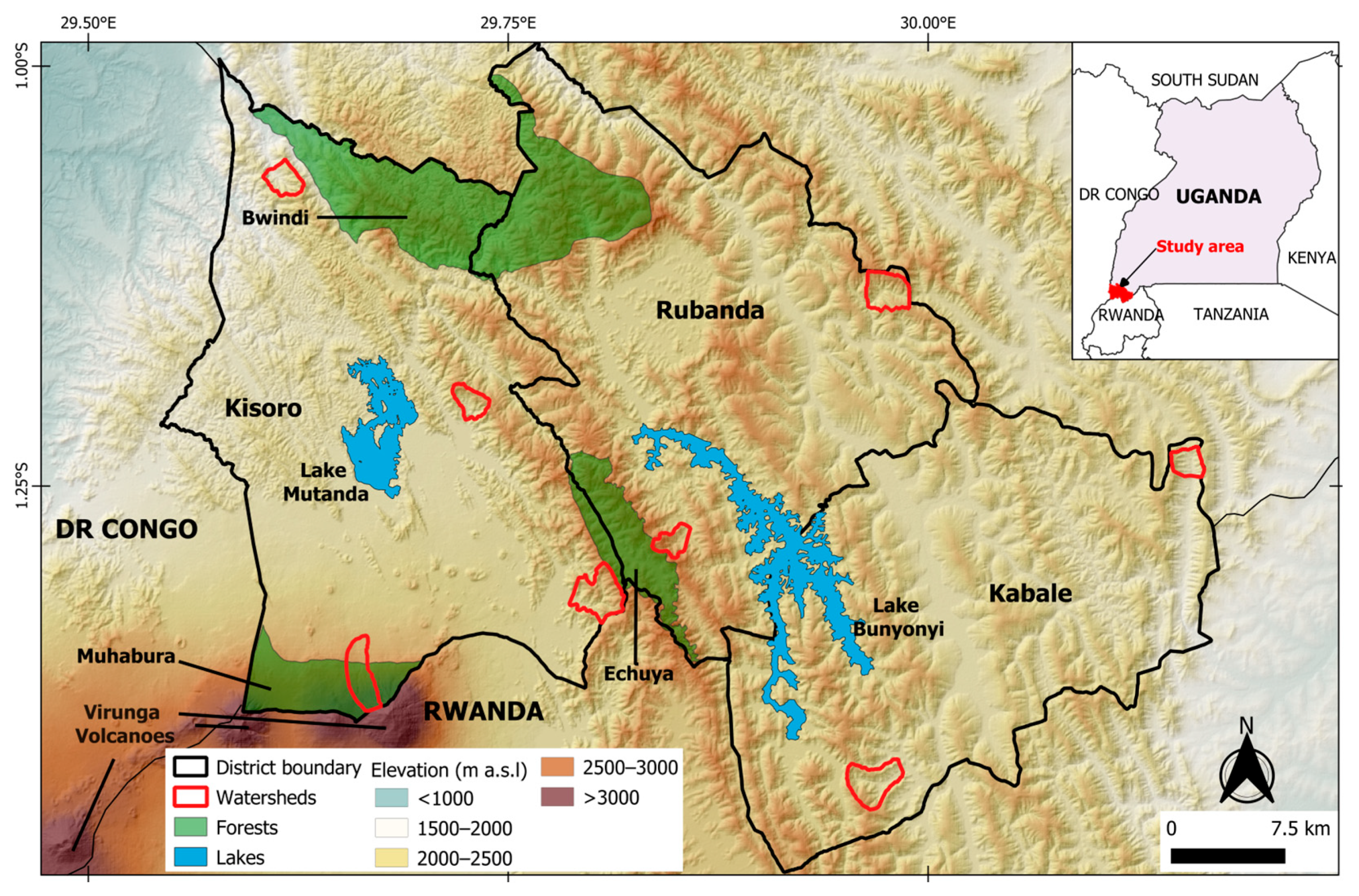





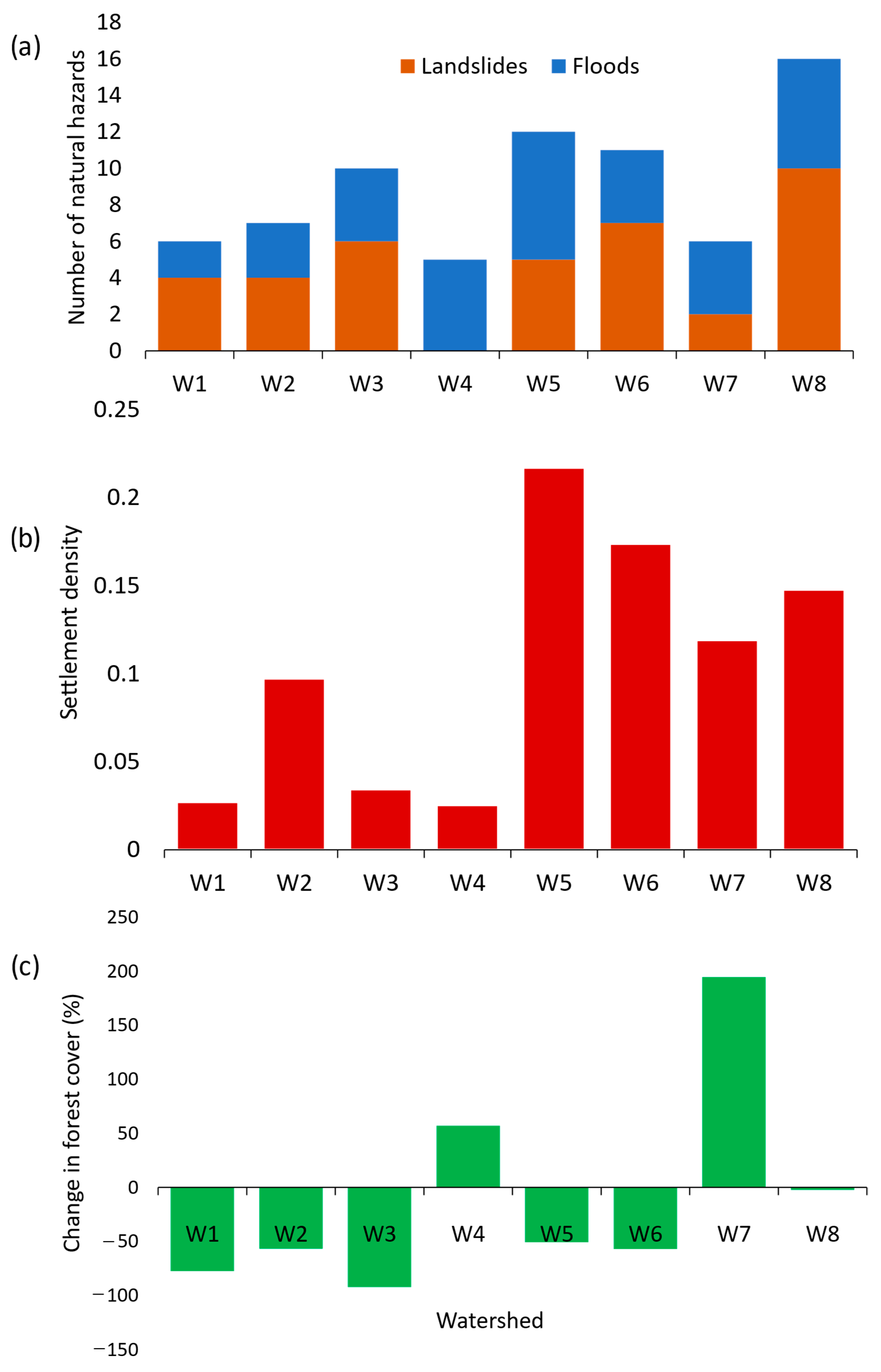
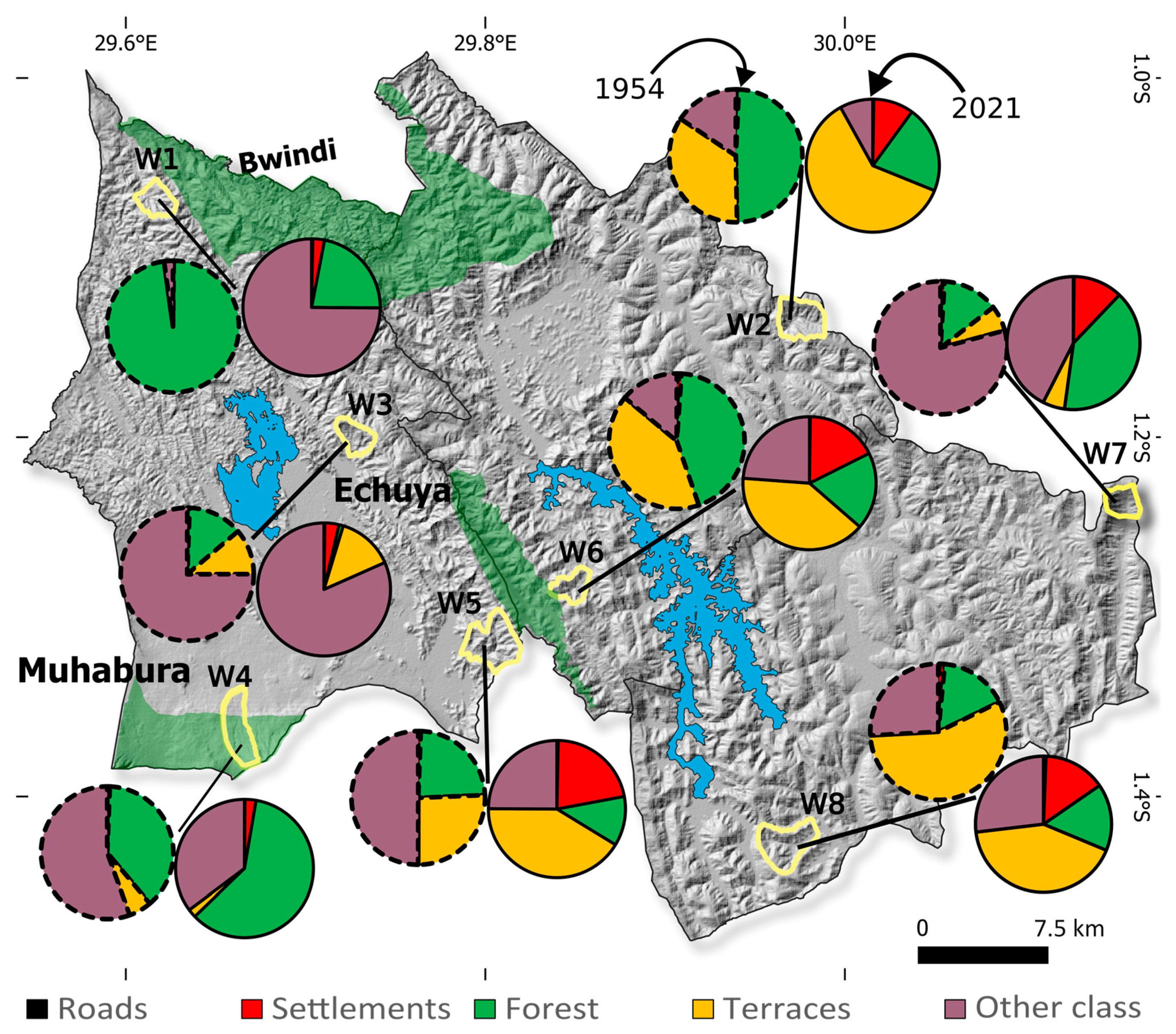
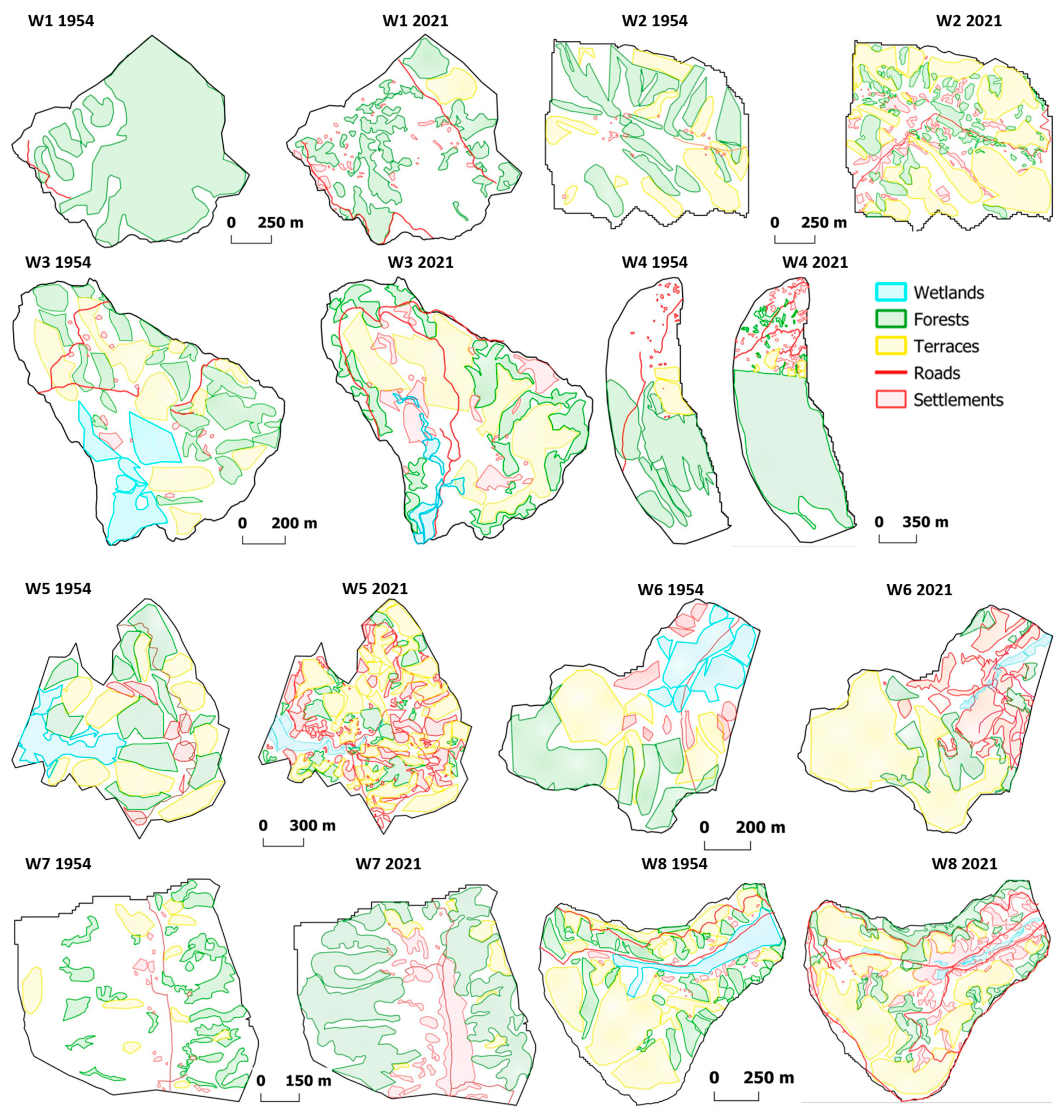
| Watershed | Size (km2) | Land Use/Cover | Average Slope (%) | Lithology | Level of Human Disturbance | Frequent Natural Hazards |
|---|---|---|---|---|---|---|
| W1 | 3.5 | Forest, shrubs, crops (millet, tea, sweet potatoes, beans). Settlements on hilltops and upper slopes | 48 | Mudstone, shale, slate, phyllite | Low | Landslides |
| W2 | 4.5 | Eucalyptus, crops (maize, potatoes, beans), agricultural terraces, drained wetland | 42 | Mudstone, shale, slate, phyllite, sandstone, quartzite, grit | Moderate | Landslides, flash floods |
| W3 | 7.2 | Eucalyptus, crops (beans, maize, sweet potatoes), agricultural terraces, drained wetland | 49 | Mudstone, shale, slate, phyllite | Moderate | Landslides, flash floods |
| W4 | 6.7 | Forest, eucalyptus, crops (potatoes, climbing beans, maize), ridges | 34 | Leucite, basanite | Moderate | Flash floods |
| W5 | 8.2 | Eucalyptus, crops (potatoes, climbing beans), rock outcrops on upper slopes, wetland under cultivation | 47 | Mudstone, shale, slate, phyllite, sandstone, quartzite, grit | High | Flash floods |
| W6 | 3.2 | Eucalyptus, crops (climbing beans, potatoes, maize), agricultural terraces, gullies | 40 | Mudstone, shale, slate, phyllite, sandstone, quartzite, grit | High | Floods |
| W7 | 3.5 | Eucalyptus, pine, grassland on hilltops. Settlements mainly in the valley, crops (banana, sorghum, peas) | 39 | Mudstone, shale, slate, phyllite, sandstone, quartzite, grit | Low | Landslides, flash floods |
| W8 | 7.2 | Eucalyptus, crops (sorghum, beans, maize), agricultural terraces, gullies, numerous gravel roads, drained wetland | 39 | Mudstone, shale, slate, phyllite | High | Landslides, flash floods |
Disclaimer/Publisher’s Note: The statements, opinions and data contained in all publications are solely those of the individual author(s) and contributor(s) and not of MDPI and/or the editor(s). MDPI and/or the editor(s) disclaim responsibility for any injury to people or property resulting from any ideas, methods, instructions or products referred to in the content. |
© 2025 by the authors. Licensee MDPI, Basel, Switzerland. This article is an open access article distributed under the terms and conditions of the Creative Commons Attribution (CC BY) license (https://creativecommons.org/licenses/by/4.0/).
Share and Cite
Kanyiginya, V.; Twongyirwe, R.; Mubiru, D.; Michellier, C.; Ashepet, M.G.; Kagoro-Rugunda, G.; Kervyn, M.; Dewitte, O. Historicizing Natural Hazards and Human-Induced Landscape Transformation in a Tropical Mountainous Environment in Africa: Narratives from Elderly Citizens. Land 2025, 14, 346. https://doi.org/10.3390/land14020346
Kanyiginya V, Twongyirwe R, Mubiru D, Michellier C, Ashepet MG, Kagoro-Rugunda G, Kervyn M, Dewitte O. Historicizing Natural Hazards and Human-Induced Landscape Transformation in a Tropical Mountainous Environment in Africa: Narratives from Elderly Citizens. Land. 2025; 14(2):346. https://doi.org/10.3390/land14020346
Chicago/Turabian StyleKanyiginya, Violet, Ronald Twongyirwe, David Mubiru, Caroline Michellier, Mercy Gloria Ashepet, Grace Kagoro-Rugunda, Matthieu Kervyn, and Olivier Dewitte. 2025. "Historicizing Natural Hazards and Human-Induced Landscape Transformation in a Tropical Mountainous Environment in Africa: Narratives from Elderly Citizens" Land 14, no. 2: 346. https://doi.org/10.3390/land14020346
APA StyleKanyiginya, V., Twongyirwe, R., Mubiru, D., Michellier, C., Ashepet, M. G., Kagoro-Rugunda, G., Kervyn, M., & Dewitte, O. (2025). Historicizing Natural Hazards and Human-Induced Landscape Transformation in a Tropical Mountainous Environment in Africa: Narratives from Elderly Citizens. Land, 14(2), 346. https://doi.org/10.3390/land14020346














